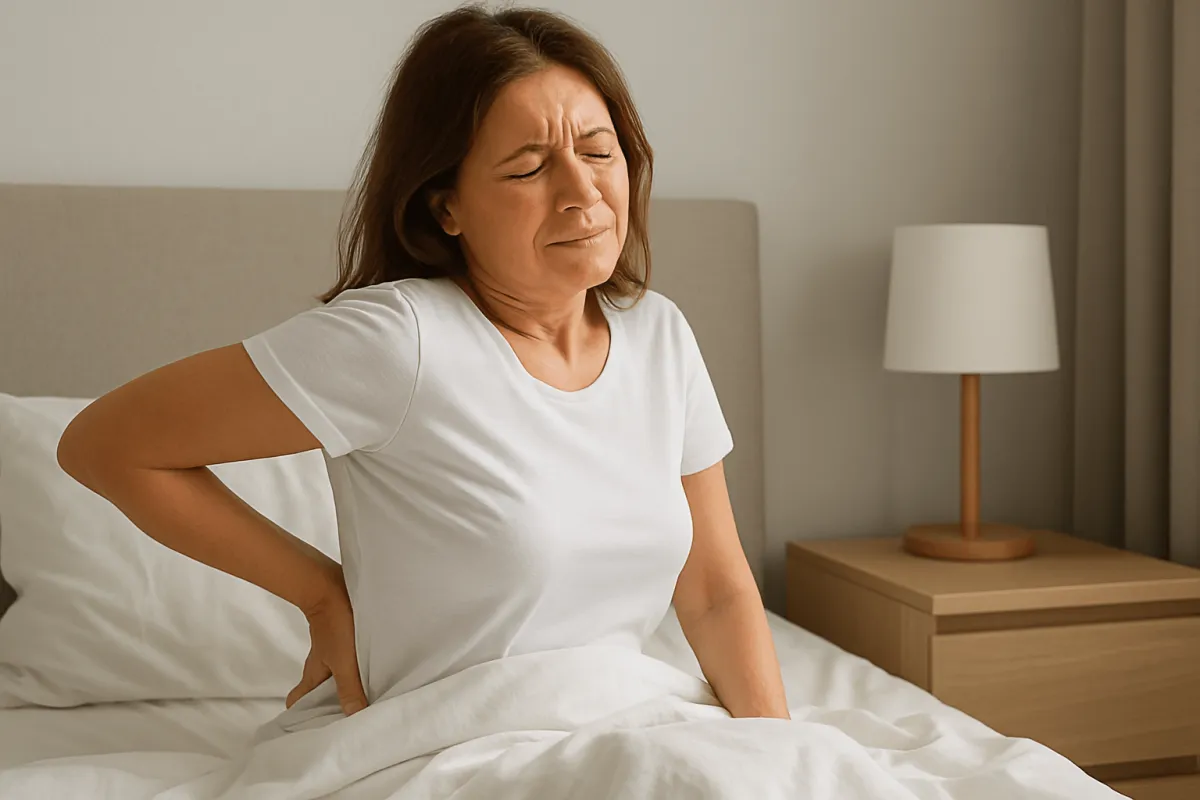
Why Morning Back Pain Happens—And The Really Simple Fix
Do you ever wake up in the morning stiff, sore, and wondering what you did overnight to deserve back pain? You’re not alone. Many people feel fine during the day, only to wake up aching after hours of rest.
It seems backward—shouldn’t sleep help you heal? The truth is, morning back pain is often caused by simple, overlooked factors that disrupt your pelvis and strain your joints while you sleep.
The good news? Once you understand why it happens, there’s a really simple fix that can make mornings feel good again.
Why Morning Back Pain Happens
During the night, your body is still. That’s when hidden imbalances have the most impact:
The pelvis slips out of place. If your sacroiliac (SI) joints are even slightly unstable, lying still for hours allows them to drift, overstretching ligaments and firing up nerves.
Sleeping position strains the joints. Side sleepers may pull one knee too far up, tilting the pelvis. Back sleepers may arch too much. Stomach sleepers twist their spine and hips unnaturally.
Mattress or pillow mismatch. A bed that’s too soft, too hard, or doesn’t support your natural curves adds extra stress to ligaments.
Even small shifts during sleep can cause ligaments to stretch, joints to misalign, and nerves to become irritated—setting you up for pain before your day even starts.
Signs Your Morning Pain Is Sleep-Related
Not sure if sleep is the culprit? Some telltale clues include:
Pain is worst in the morning, but eases after moving around
Stiffness when rolling over or getting out of bed
One-sided pain if you always sleep on the same side
Relief when changing pillows, mattresses, or positions
Pain that doesn’t show up on scans or during daytime activity
If this sounds familiar, your nighttime habits may be the hidden trigger.
Why Doctors Often Miss It
Morning back pain often gets lumped into vague labels like “arthritis,” “aging,” or “nonspecific pain.” But many providers don’t consider pelvic alignment, sleeping positions, or ligament health.
Since pelvic misalignments usually don’t show up on imaging, patients are left without answers—or told it’s just something they’ll have to live with.
But there’s no reason to accept mornings full of pain when simple fixes can make a big difference.
The Really Simple Fix
Here’s the 3-step method I taught my patients for preventing morning back pain:
🔹 Step 1: Realign Before Bed
A gentle two-minute lunge stretch helps put the SI joints back into place before you sleep. This keeps ligaments from being pulled unevenly overnight.
🔹 Step 2: Support While You Sleep
Side sleepers: Place a pillow between the knees to prevent pelvic tilt.
Back sleepers: Use a pillow under the knees to keep the pelvis neutral.
Stomach sleepers: Best to avoid, but if you must, place a pillow under the hips to reduce strain.
A supportive mattress and proper pillow height also make a huge difference.
🔹 Step 3: Ease Into the Morning
Don’t leap out of bed. Start by gently rolling to one side, pulling your knees in slightly, and pushing up with your arms. This protects the pelvis from sudden strain and lets your muscles warm up.
Practical Tips for Better Nights
Check your mattress. If it sags or causes your hips to dip, it’s time for a replacement.
Stretch lightly before bed. Calms tight muscles and resets the pelvis.
If you are uncomfortable, change your position!
Keep warm. Cold muscles stiffen more easily—consider a warm shower before bed.
Mind evening stress. Stress makes muscles tighten, carrying tension into the night. A few minutes of relaxation can change your morning.
What About Relief Right Now?
If you’re already sore when you wake up, don’t panic. Relief can be quick.
I often recommend QR Cream, a topical treatment I developed that contains mannitol, a natural sugar compound that reduces nerve sensitivity just under the skin. Applied to sore areas, it calms pain signals while your joints and ligaments reset.
Why This Matters
Mornings should set you up for the day—not leave you hobbling before breakfast. Too many people assume waking up with pain is “normal” or something they just have to live with. But often the cause is simple: pelvic misalignment, poor support, or tension carried into the night.
By addressing these factors, you can stop dreading mornings and start the day feeling rested, comfortable, and pain-free.
Let’s Recap
✅ Morning back pain often comes from pelvic misalignment and poor sleep positions
✅ Doctors miss it because it often doesn’t show up on scans
✅ The fix: realign before bed, support while you sleep, and ease into mornings
✅ Practical changes—plus QR Cream—can bring quick relief
✅ You don’t have to live with painful mornings
Want to Learn More Ways to Relieve Back Pain Naturally?
🎥 Register for my free webinar: Live Without Pain
I’ll share natural ways to heal your body—without drugs or surgery.
For step-by-step guidance, you can also check out my book: “Low Back Pain: 3 Steps to Relief in 2 Minutes.”
Wishing you calm, comfort, and true healing,
— Hélène Bertrand, MD (retired)
CLICK HERE TO RECEIVE LOW BACK PAIN RELIEF in 2 MINUTES!
Disclaimer: This content is for informational and educational purposes only and does not substitute professional medical advice, diagnosis, or treatment. Always consult your healthcare provider before starting any new treatment or making changes to your health regimen. Although Dr. Bertrand is a retired medical doctor, she is not practicing medicine or providing medical care through this website.
